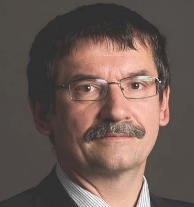Ákos Zarándy
At the end of 1990, he started working alongside the university as a research associate at the Hungarian Academy of Sciences' Computer Science and Automation Research Institute (SZTAKI) in Tamás Roska's Analog and Neural Computing Laboratory.
After graduating from university, he began his postgraduate studies, during which he spent more than two years at the University of California, Berkeley, as a visiting student, then as a visiting researcher in Leon Chua's Nonlinear Circuits Laboratory and in Frank Werblin's retina research laboratory. In 1995, he received the Hungarian State Eötvös Scholarship. In 1997, he obtained the title of Candidate of Technical Sciences of the Hungarian Academy of Sciences (MTA); later he became a doctor of the MTA. In 1999, he received the General Electrics Scholarship and in 2000, the Dénes Gábor Patent Application Award.
Between 2000 and 2005, he was the founding managing director of AnaLogic Computers Kft., a subsidiary of SZTAKI, part-time. From 2005 to 2006, he was the technical director of Eutecus Inc. (Berkeley, California, USA). Since 2012, he has been the head of the SZTAKI Computational Optical Sensing and Processing Research Laboratory, and a scientific advisor to SZTAKI.
Since 2005, he has been teaching the subject Embedded Electronic Systems as an associate professor at the Faculty of Information Technology and Bionics (ITK) of Pázmány Péter Catholic University (PPKE). He habilitated in 2011 and has been a university professor at PPKE since 2012. He is a core member of the Tamás Roska Doctoral School of Engineering and Natural Sciences at PPKE.
His scientific interest focused on Cellular Neural Networks (CNN) as programmable processor arrays. Within this, he investigated the feasibility of these devices and their usability in image processing. When programmable CNN chips appeared, he was responsible for the first development system, with the help of which these new architecture cellular microprocessor chips could be tested and algorithmically programmed (for this, he created a new computing infrastructure, including the development of hardware elements, operating system development, low-level language definition, and compiler development). Later, under his leadership, several development systems and a CNN-based visual computer that could be used in industry were completed, for which he also developed algorithms and applications (television image enhancement experiments; implementation of a mathematical morphology toolbox; algorithm family for computer analysis of mammography images). Another application targeted extremely high-speed image processing (he created a CNN-based system for examining engine spark plugs, capable of capturing and evaluating 10,000 images in real time).
He took a leading role in initiating the introduction of CNN-based computers into daily industrial practice at SZTAKI - when CNN technology reached the appropriate level of development.
Since the 2010s, his focus has shifted to specialized visual sensors (he has worked on multi- and hyper-spectral sensors, digital holographic microscopes, unmanned aerial vehicle (UAV) vision systems, and medical image processing). He and his group have developed a visual patient monitoring system that can remotely monitor the vital signs and cycles of premature infants without contact.
He holds two patents (2000, 2016). He has published over 200 papers.
He is the chairman of the Hungarian Academy of Sciences' Automation and Computer Engineering Committee. He is a member of the Institute of Electrical and Electronics Engineers (IEEE) Circuits & Systems Society Sensory Systems (SS) technical Committee.
Awards: János Kemény Award (NJSZT, 2002); Product of the Year Award ("Bi-i camera", Stuttgart Vision fair, 2003); Best paper award (“Per-pixel integration time controlled image sensor”, ECCTD (European Conference on Circuit Theory and Design), Ireland, 2005); Microprocessor Report Innovation Award (San Jose, California: Superfast Sensor-Processors Break New Ground in Digital Imaging, 2007); Károly Simonyi Award (American Hungarian and Arany János Public Foundation for Science, 2007); Civilian Division of the Officer's Cross of the Hungarian Order of Merit (President of the Republic, 2021).
- Married, has three children. (2018 announcement.)
Created: 2020.07.13. 12:36
Last modified: 2025.03.16. 17:09

